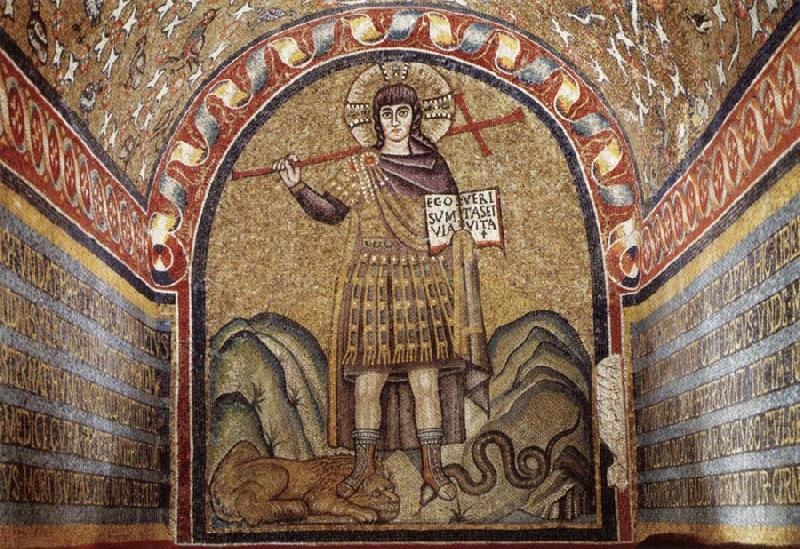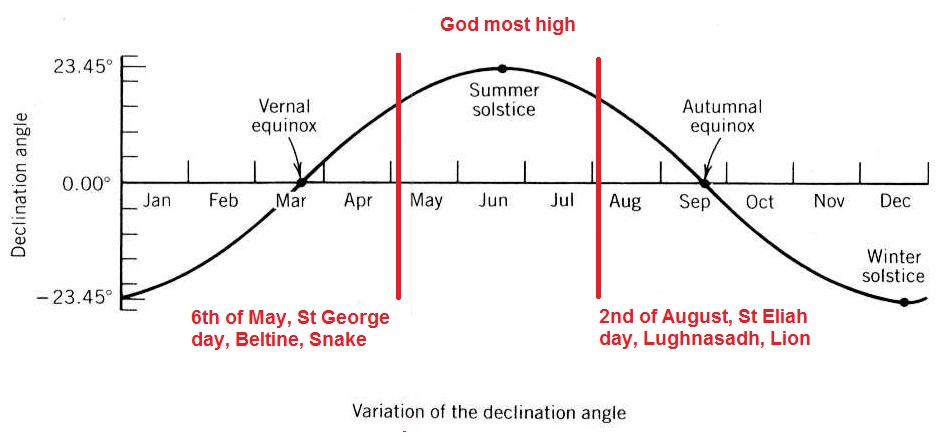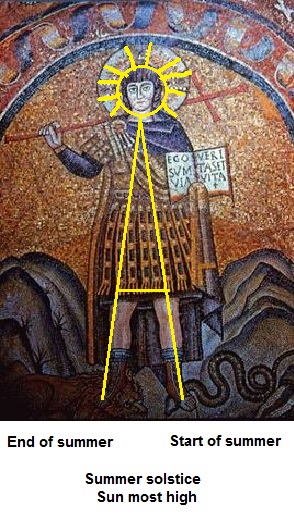© tłumaczenie Czesław Białczyński
Have you ever heard of the Psalm 91 (Greek numbering: Psalm 90), also known as the Psalm of Protection?
The psalm starts with:
Whoever dwells in the shelter of the Most High
will rest in the shadow of the Almighty…
And goes on to proclaim:
…If you say, “The Lord is my refuge,”
and you make the Most High your dwelling…
…you will trample the great lion and the serpent…
Czy kiedykolwiek słyszeliście o Psalmie 91 (numeracja grecka: Psalm 90), znanym również jako Psalm Ochrony?
Psalm zaczyna się od słów:
Kto mieszka w schronieniu Najwyższego
Odpocznie w cieniu Wszechmogącego …
I dalej głosi:
… Jeśli powiesz: „Pan jest moim schronieniem”
I ustanowisz Najwyższego swoim gniazdem …
… zdepczesz Wielkiego Lwa i Węża ..
This last bit, the verse 13, interpreted as a reference to Christ defeating and triumphing over Satan, was the origin of the iconography of „Christ treading on the beasts„, seen in the Late Antique period, and revived in Carolingian and Anglo-Saxon art. The earliest and one of the most beautiful example of the depiction of the „Christ treading on the beasts” scene can be found in the „Basilica of San Vitale” in Ravenna.
Ten ostatni fragment, werset 13, interpretowany jest jako odniesienie do Chrystusa pokonującego i triumfującego nad Szatanem. Był on początkiem ikonografii „Chrystusa podbijającego bestie”, znanego w okresie późnego antyku i Odrodzenia sztuki w czasach Karolingów i Anglosasów. Pierwszy i jeden z najpiękniejszych przykładów obrazowania sceny „Chrystus podążający za bestiami” można znaleźć w „Bazylice San Vitale” w Rawennie.

http://oldeuropeanculture.blogspot.com/2017/06/you-will-trample-great-lion-and-serpent.html
The „Basilica of San Vitale” in Ravenna, Italy is one of the most important examples of early Christian Byzantine art and architecture in Europe. The church was begun by Bishop Ecclesius in 526, when Ravenna was under the rule of the Ostrogoths and completed by the 27th Bishop of Ravenna, Maximian, in 547 preceding the Byzantine Exarchate of Ravenna. The church is famous for its mosaics.
What is the meaning of the above image?
Christian doctrine says that Jesus is trampling on the lion and the snake because „these animals are symbol of the Devil”. Hence he is trampling the Devil. But I believe that there is another, hidden meaning.
„Bazylika San Vitale” w Rawennie, we Włoszech jest jednym z najważniejszych przykładów wczesnej sztuki chrześcijańskiej i architektury bizantyjskiej w Europie. Budowę kościoła rozpoczął biskup Ecclesius w roku 526, kiedy to Ravenna znajdowała się pod panowaniem Ostrogotów. Budowę zakończył 27. biskup Rawenny, Maximian, w roku 547. Kościół słynął ze swoich mozaikowych obrazów.
Jakie jest znaczenie powyższego obrazu?
Chrześcijańska doktryna mówi, że Jezus depcze lwa i węża, ponieważ „te zwierzęta są symbolem Diabła”. Depcze tkwiącego w nich diabła. Ale wierzę, że jest inne, ukryte znaczenie.
In my post „Three suns” I talked about the symbolic link between Snakes and the light and heat of the sun. This link was clearly preserved in Slavic mythology. Snakes come out of hibernation just before the the Spring Equinox. Snakes go back to hibernation just after the Autumn Equinox. So snakes are out during the period between Spring and Autumn Equinoxes, during the brightest and hottest part of the year. Slavs believed that once out, snakes constantly „suck the heat out of the sun” and that this is why sun eventually looses it’s light and heat and days get shorter and shorter and colder and colder.
W moim poście „Trzy słońca” pisałem o symbolicznym związku między wężem a światłem i ciepłem promieniowania słońca. Ten związek był wyraźnie zachowany w mitologii słowiańskiej. Węże wychodzą z hibernacji tuż przed Równonocą Wiosenną. Węże wracają do hibernacji tuż po Równonocy Jesiennej. Węże są obecne na powierzchni ziemi w okresie między wiosną i jesienią (między równonocami), podczas najjaśniejszej i najgorętszej części roku (Mowa tutaj o Północy EuroAzji, czyli Królestwie SIS. CB). Słowianie wierzyli, że węże stale „wysysają ciepło słońca” i dlatego właśnie słońce traci światło i ciepło, a dni staja się coraz krótsze, krótsze, zimniejsze i zimniejsze.
 Right in the middle of this period is summer.
Right in the middle of this period is summer.
Summer starts on the 6th of May, Day of Jarilo, Beltine. Jarilo represents the sun’s heat, symbolized by the snake and the dragon. Funnily Jarilo was Christianized into St George, the Dragon killer 🙂 In Serbia, St Jeremija who is celebrated at the beginning of May is known as the Snake Saint. His day (1st of May according to the Julian calendar, 14th of May according to the Gregorian calendar) is the time when people perform magic ceremonies for protection from snakes…Interesting both names Jarilo and J(a)eremija have the root „jar” meaning „bright heat”.
Summer ends on the 2nd of August, Day of Perun, Lughnasadh. Day of Perun falls in the middle of the Leo (Lion) zodiac sign.
W samym środku tego okresu jest lato.
Lato zaczyna się 6 maja, dzień Jaryły, Beltine. Jaryło reprezentuje ciepło i energię słońca, symbolizowane przez węża i smoka. Radosny Jaryło został schrystianizowany przez Świętego Jerzego pogromcę Smoka/Żmija. W Serbii Święto Jeremija, obchodzone jest na początku maja. Znane jest ono jako Święto Węży/Żmijów. Jego dzień (1 maja według kalendarza Juliana, 14 maja według kalendarza gregoriańskiego) to czas, w którym ludzie wykonują magiczne ceremonie ochrony przed wężami … Ciekawe, że nazwy Ja-rilo i J(a)ere-mija mają korzeń „jar”oznaczający „jasne, ciepło”.
Letni koniec 2 sierpnia, Dzień Peruna, Lughnasadh. Dzień Peruna przypada na środku znaku zodiaku Leo (Lew).
 So summer is the period between the Day of Jarilo (Snake) and the Day of Perun (Lion). And in the middle of the summer is Day of Svetovid, the Summer solstice. The point when Sun in the northern hemisphere reaches its highest point above the horizon.
So summer is the period between the Day of Jarilo (Snake) and the Day of Perun (Lion). And in the middle of the summer is Day of Svetovid, the Summer solstice. The point when Sun in the northern hemisphere reaches its highest point above the horizon.
Now have a look at „Christ treading on the beasts” scene again:
Christ standing with his legs spread, with one leg on the snake (the beginning of the summer) and the other leg on the lion (the end of the summer). His head, with the solar halo is right at the point of the summer solstice, when Sun god is the most high…
If you make the Most High your dwelling…you will trample the great lion and the serpent…
You will be in the summer on the northern hemisphere…
Lato to okres pomiędzy Dniem Jaryły (Wąż/Żmij/Smok) a Dniem Peruna (Lew). A w połowie lata jest dzień Svetovida, przesilenie letnie. Punkt, w którym Słońce na półkuli północnej osiąga najwyższy punkt nad horyzontem.
Teraz spójrz na scenę „Chrystusa Podbijajaćego Bestie”:
Chrystus stojący w rozkroku oparty jest stopami na zwierzętach, jedną nogą na wężu (początek lata), a drugą nogą na lwie (koniec lata). Jego głowa, z promieniami słonecznym, jest w punkcie letniego przesilenia, kiedy Bóg Słońca jest najbardziej obecny na Ziemi…
… Jeśli powiesz: „Pan jest moim schronieniem”
I ustanowisz Najwyższego swoim gniazdem …
… zdepczesz Wielkiego Lwa i Węża ..
Będziesz w lecie na północnej półkuli …

Czy takie jest znaczenie tego psalmu i tego obrazu? Tak mi się wydaje. A ty co myślisz?
http://oldeuropeanculture.blogspot.com/2017/06/you-will-trample-great-lion-and-serpent.html
